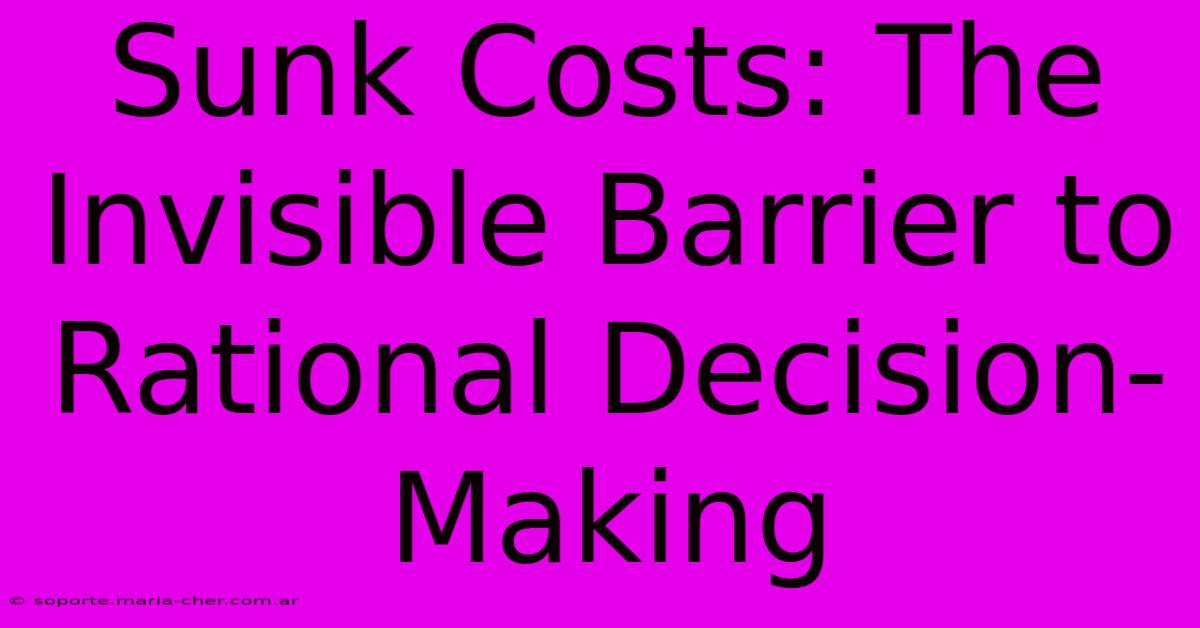Sunk Costs: The Invisible Barrier To Rational Decision-Making

Table of Contents
Sunk Costs: The Invisible Barrier to Rational Decision-Making
We've all been there. You've invested time, money, or effort into something – a project, a relationship, a course – and it's clearly not working out. Yet, you keep going, clinging to the hope that things will magically improve. This is the insidious trap of sunk costs. Understanding sunk costs and how they affect our decision-making is crucial for making rational choices and avoiding unnecessary losses.
What are Sunk Costs?
Sunk costs are expenses that have already been incurred and cannot be recovered. They're essentially past investments. Think of the money you've already spent on that gym membership you barely use, the hours you've poured into a failing project, or the time invested in a relationship that's clearly not fulfilling. These are all examples of sunk costs. The key characteristic is that they are unrecoverable.
Examples of Sunk Costs in Everyday Life:
- Financial investments: Money spent on a depreciating asset, a failing business venture, or a stock that's plummeting.
- Time investments: Hours spent on a project that's going nowhere, attending a boring conference, or pursuing a hobby you no longer enjoy.
- Effort investments: The energy expended on a relationship that's toxic, a job you hate, or a goal you've lost interest in.
The Sunk Cost Fallacy: Why We Keep Throwing Good Money After Bad
The sunk cost fallacy is the tendency to continue investing in something simply because you've already invested so much, regardless of its current value or future prospects. It's an emotional bias that overrides rational decision-making. We feel compelled to justify our past decisions, even if it means continuing to waste resources.
This fallacy manifests in various ways:
- Continuing a failing project: Instead of cutting losses and moving on, you keep pouring resources into a project that's unlikely to succeed.
- Staying in a bad relationship: You remain in a dysfunctional relationship, clinging to the investment of time and emotion, despite the unhappiness.
- Finishing a disliked book or movie: You force yourself to finish a book or movie you're not enjoying, solely because you've already started it.
The Psychology Behind the Sunk Cost Fallacy:
- Cognitive Dissonance: We want to maintain consistency in our beliefs and actions. Continuing to invest in something, despite its flaws, avoids admitting a past mistake.
- Loss Aversion: The pain of losing something is often felt more strongly than the pleasure of gaining something of equal value. We're more motivated to avoid losses than to acquire gains.
- Confirmation Bias: We tend to seek out information that confirms our existing beliefs and ignore information that contradicts them. This can lead us to overlook the negative aspects of a sunk cost investment.
How to Overcome the Sunk Cost Fallacy:
Breaking free from the sunk cost fallacy requires a conscious effort to focus on the future, not the past. Here's how:
- Recognize the fallacy: Be aware of the sunk cost fallacy and its influence on your decision-making.
- Separate past from future: Make decisions based on future potential, not past investments. Ask yourself: "Would I invest in this now, knowing what I know?"
- Focus on opportunity costs: Consider what else you could be doing with your time, money, and energy.
- Cut your losses: Don't be afraid to walk away from something that's not working, even if it means acknowledging a past mistake.
- Practice mindfulness: Pay attention to your emotions and identify when sunk cost bias is influencing your choices.
Conclusion: Making Rational Decisions, One Sunk Cost at a Time
The sunk cost fallacy is a common cognitive bias that can lead to poor decisions and wasted resources. By understanding its underlying mechanisms and employing strategies to overcome it, we can make more rational choices and avoid the trap of throwing good money (and time and effort) after bad. Remember, letting go of sunk costs is not admitting defeat; it's making a smart decision for your future.

Thank you for visiting our website wich cover about Sunk Costs: The Invisible Barrier To Rational Decision-Making. We hope the information provided has been useful to you. Feel free to contact us if you have any questions or need further assistance. See you next time and dont miss to bookmark.
Featured Posts
-
The Secret To A Hollywood Smile Dnd Gel 861 Whiten Strengthen And Protect
Feb 04, 2025
-
The Unsubscribe Enigma Solved How Mailer Lite Empowers You To Conquer
Feb 04, 2025
-
Pro Grade Sd Card The Secret To Stunning 4 K Video And High Res Images
Feb 04, 2025
-
See The Controversial Saints Logo Thats Sparking Fierce Debate
Feb 04, 2025
-
Tune Your Canon Camera Master Custom Picture Styles For Stunning Results
Feb 04, 2025
